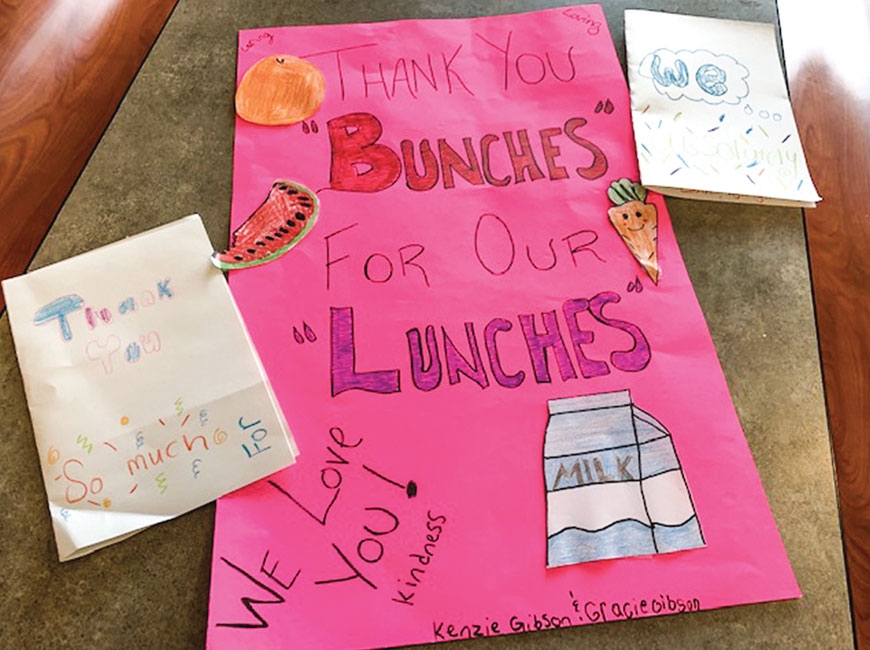Schools keep kids fed during pandemic

North Carolina is regularly ranked as one of the 10 hungriest states in the nation. According to Feeding America data from 2018, North Carolina had a child food insecurity rate of 19.3 percent, with Haywood County at a rate of 21 percent. During the pandemic, Feeding America found that a majority of food banks report seeing a record increase in the number of people needing help, with an average increase of 60 percent across the country.
Many children in the United States depend heavily on school meals for regular sustenance. The USDA and local school nutrition programs have been working to ensure that doesn’t change during the pandemic.
“I think that this will go to show how essential school nutrition employees are to our community and to feeding,” said Jennifer Brown, director of school nutrition for Swain County.
The United States Department of Agriculture is responsible for funding that provides free and reduced lunches in schools. In normal years, they also fund the Summer Food Service Program that provides meals to children that need it while they are not in school. During the COVID-19 Pandemic, this service has been extended several times to allow for the continuation of free meals. On Oct. 9, flexibilities in the Summer Food Service Program and Seamless Summer Option were extended through June 30, 2021.
The Summer Food Service Program is a federally funded, state-administered program that reimburses those who serve free, healthy meals and snacks to children and teens in low-income areas. The waivers and extensions for the SFSP and SSO mean that meals can be served in all areas at no cost to families, meals can be served outside of typically-required group settings and meal times, and parents and guardians can pick up meals for their children.
During normal years, school nutrition services give out applications for free and reduced lunch. Those who do not qualify have to pay for school meals. Because of the reimbursements given by the USDA, schools have been able to serve free meals to all students during the pandemic.
Related Items
“USDA has allowed us to offer free meals to all children ages 1 to 18,” said Alison Francis, director of school nutrition for Haywood County. “Once the meals are served, we turn in a claim to USDA and they reimburse us for every meal served. The parents have not had to fill out a free and reduced application to receive these benefits.”
Even with the reimbursements from USDA, some school nutrition departments are still feeling the effects of not having students in school regularly.

Robin Smith and Karen Jones load food for a family at Bethel Middle School. Donated photo
“One thing I can say that’s been extremely hard for us is that extra revenue that we were able to have in the past from selling extra items, what we call a la carte items. That’s a huge revenue for us and we’re not meeting a quarter of that as that right now,” said Laura Cabe, director of school nutrition for Jackson County.
The irregularities of this school year have presented incredible challenges for school nutrition departments, not only in the form of funding. The sheer technicalities of the transformations nutrition services have had to undergo has been daunting. From regular child nutrition services to full-time distribution of meals while kids were stuck at home, to some combination of the two.
“The hardest part of our work has been the unknown of what tomorrow’s going to bring. I mean we were not able to do a whole lot of planning, future planning, which is somewhat important for school nutrition to be able to do. Especially with your purchase of food or staffing,” said Brown.
School nutrition departments have also had to look out for their own. Not an easy task during a time of reduced income. According to Cabe, participation in school lunches in Jackson County are down to almost half the number they would serve in normal times.
“Even though the reimbursement is a little bit higher, our participation is a lot lower because we only have half of the students there. And even though we’re sending home meals as much as we can and having pick-up lines, it’s still not near, maybe half, of the lunch participation we would do in a normal year,” she said.
Cabe said administration decided at the beginning of the pandemic they would not cut anyone or reduce any hours. However, JCPS has several open positions in the nutrition department that they can’t afford to fill at the moment.
“I think the biggest challenge for me has been that I just care very deeply about the staff as well as the community and feeling like it’s on my shoulders I think has been the hardest part. Just making sure everybody’s fed, everybody’s safe, everybody still has their job,” Cabe said.
In Haywood County Schools, though there is more breakfast being served than in normal years, lunch numbers are down by about 1,000 per day.
“We’re probably doing a hundred meals a day at our curbside pickup location, but that doesn’t compare, come anywhere close to the number of kids that are either remote only, or on the virtual rotation. So there are a lot of those kids that aren’t taking advantage of it,” said Francis.
Whether those students don’t need the meal service or are unable to get to the pick-up location is impossible to determine.
In Swain County, Brown says, they are feeding slightly more meals than in normal years. This is because under the extended Summer Food Service Program, they can feed kids that are not enrolled in Swain County Schools, for example students in charter schools, or homeschoolers.
Swain County Schools has also worked out a system to run school busses for food delivery on Wednesdays, when all students are remote. They run six different busses, covering the whole district, and give out five days-worth of meals. By doing this they ensure fully-remote learners get meals, as well as students on the AB rotation who may not be able to make it to a pick-up location during their remote days.
“The fact that during this time we’ve been able to feed all kids has been great and I wish that would continue after this is all done, you know, all kids in school could get a free meal and not have to apply for it,” said Brown.
These nutrition departments are already preparing for what might change next semester, or next school year. Preparing for the unknown.
“I’m wondering, what’s going to happen starting in January?” said Cabe. “That’s what we’re already discussing as what could be done. ‘This, this or this is what we’re gonna do in January.’ We already have that plan in line. And luckily the good part is, we’ve been down this road before so many different ways.”









